
Bill Murphy ALONG THE ARTHUR KILL 54 x 62 inches 2010 Watercolor on Paper
Bill Murphy is a Staten Island based realist artist working primarily in printmaking, drawing and painting. His website holds a dizzying array of works done since 1995 but I’m particularly drawn to his Staten Island waterfront images of urban decay, ship graveyards and other desolate scenes. Many of his scenes are what you might find in an Urban Explorers website – where adventure seekers break into abandoned hospitals, industrial building and the like. In fact, there is a link to one of these sites from his website. I find it very satisfying that a few pockets of urban wildness still survive and hasn’t yet been cleaned up so as not to spoil the view from a Starbucks window or Shopping Mall parking lot.
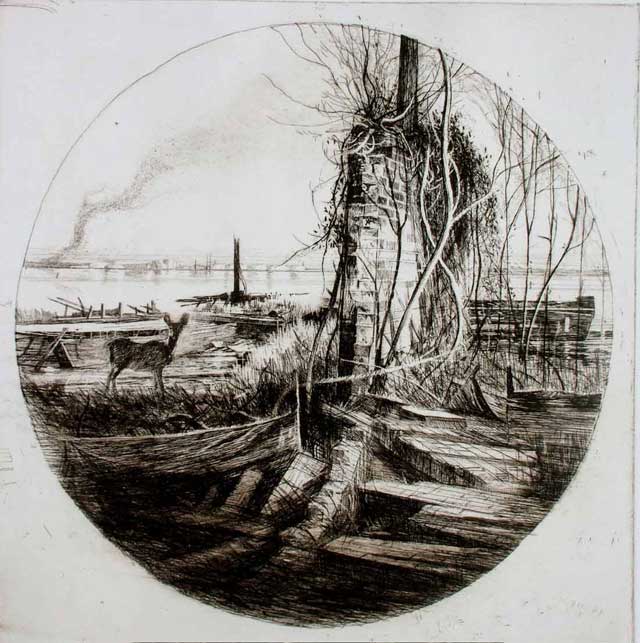
The End Days (Kreischerville Wall) 16″ x 16″ Etching on Paper
Please click for larger view (note: most all the rest of the images in this article have a larger view if clicked)
This work goes far beyond mere reporting or nostalgic reminisces to instead evoke a mood and suggest some dark narrative; as if to say you can’t simply be objective looking at this stuff, you need to take sides when confronted with such amazing views. His extremely long horizontal images of the harbor are not picturesque and panoramas but seem to channel a Rackstraw Downes on crack, the hallucinatory currents of swirling water seem to lure you into the picture only to dash you against the sharp, jagged forms of rotting piers and rusted metal.
Bill Murphy’s website has several articles about his work that are of interest. Specifically, the article he wrote called “The Soul of the Thing” which talks about his experience working on these large watercolor and prints, many done from studies or even directly done on site from observation. One of his prints of the Staten Island waterfront, “Eulogy for Kreischerville,” won first place in the American Artist magazine’s 2007 printmaking competition.
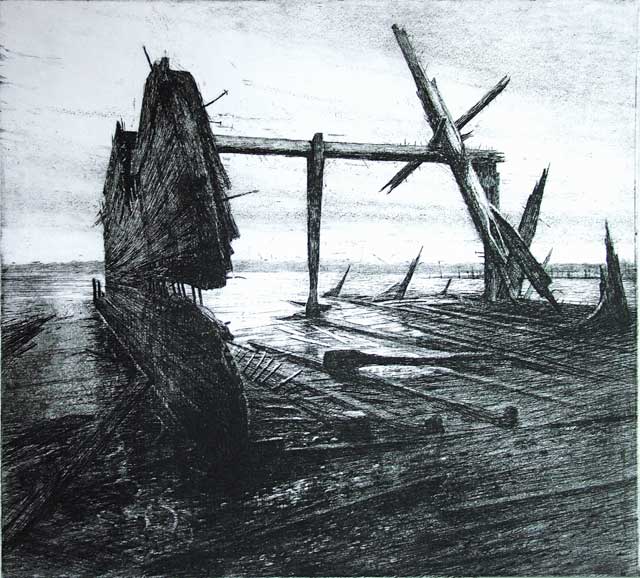
Staten Island Stonehenge (Twilight) 15 x 19″ Etching
Bill Murphy stated:
“The waterfront of Staten Island has a special place in my work,” Murphy said. “I began ‘chronicling’ it in drawings starting around 1975, and have continued up to the present. I had thought I had exhausted all the ‘boneyards’ of abandoned ships, the graveyards of wooden sailing vessels, which I find emotionally compelling.
“But in the spring of 2006, a large tract of land along the Arthur Kill was cleared for the construction of townhouses, revealing Kreischerville, a 19th-century brick factory/industrial park, where many abandoned barges, ferries, and other wooden vessels were moored. I have been painting and drawing in this area and the surrounding wood and beachfront for the last year and half.”
In a quote from another painter and occasional commenter on Painting Perceptions, Brett Busang said in “Bill Murphy and His Quest for Space”, American Arts Quarterly Winter 2005 :
“In the work of all great artists, there is at least a germ of autobiography. Wyeth considers every patch of ground home to the imagination; every place he walks is drenched in memory, filtered back to him in a way a non-artist would only vaguely understand. There is much of that sense of a personal homeland in Bill Murphy’s Staten Island images and in his work in general.”
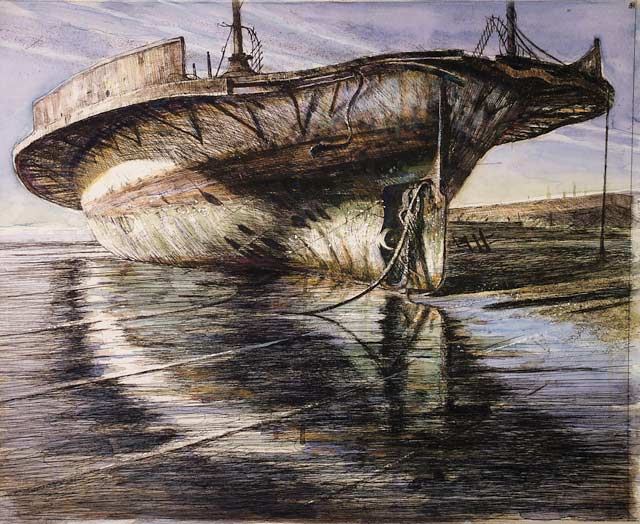
Abandoned Ferry (The Astoria) 15 x 18″ Colored Etching, Mixed Medium on Paper

The Last Boneyard 15 x 94″ Watercolor on Paper
(NOTE: please click for a larger image – can only see this image properly in this much larger view)
I exchanged a few emails with Bill Murphy for this article and he sent me a statement about his work that gives some interesting background information about his work. He stated:
My background is landscape painting and etching. For years, I would take off for the day with a pocketful of etching plates and work directly from nature–a very Whistler-like approach.
I am a realist artist who works in printmaking, drawing and paint. More specifically, I work in etching, lithography (from the stone), watercolor, oil paint, graphite and charcoal.
I believe very much in the concept of a drawing as a finished work and not just as a means of study. I find the ability to work in varied mediums helpful in maintaining my interest in my work. One of the chief obstacles for an artist is boredom, or lack of inspiration. Variety in process and subject helps to enliven my work.
My subjects are found in the world around me. I find ‘the fact’ far more interesting and strange than anything I can summon up from my imagination.
My deepest pleasure in the process of artmaking is derived when the process of drawing (or painting) can transcend the ordinary, arbitrary world and bring me into a state of contemplative reverie, a place beyond the narrow confines of thought. The picture is often just a souvenir of this trip, the roadmap of an inner journey.
Bill Murphy is a professor at Wagner College on Staten Island teaching drawing, printmaking and watercolor painting. He studied at the School of Visual Arts in Manhattan and was awarded an MFA from Vermont College. He is represented in the permanent collection of the British Museum, the Brooklyn Museum, the New York Public Library and the Staten Island Museum, among others.”
Here are a number of other images that caught my fancy… but to get the full effect you should visit his website.

My Backyard 14″ x 48″ Mixed Media Painting on Masonite
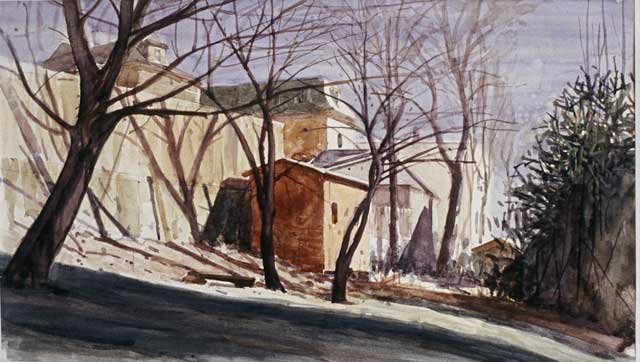
Corson Ave. Backyard 18″ x 24″ Watercolor on Paper
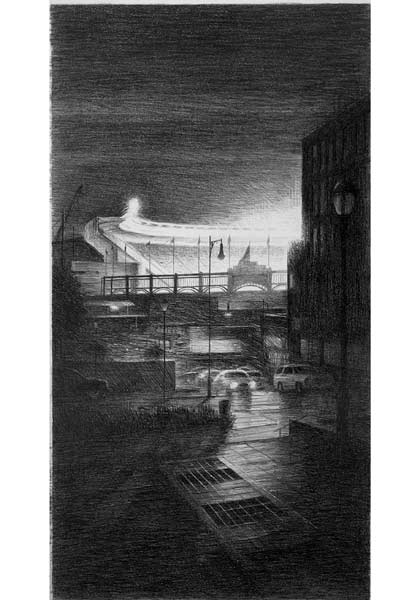
NIGHT GAME, THE BRONX 24″ x 13″ Lithograph on Paper
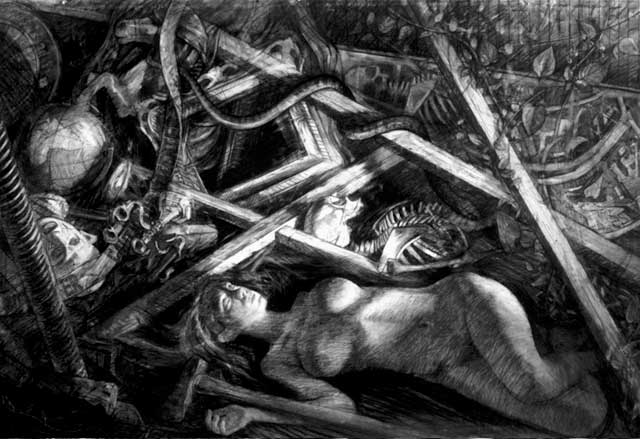
All and Everything 48 x 72″ Charcoal on Paper
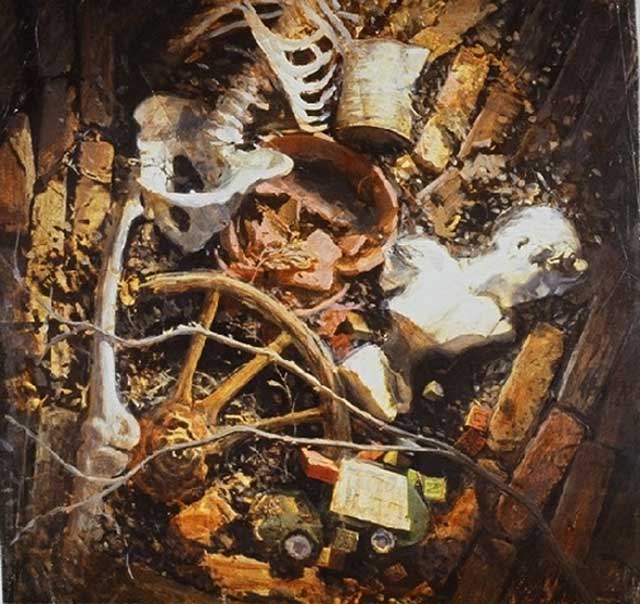
The Horses Graveyard 30 x 30″ Mixed Medium on Panel

Harvey Dinnerstein 22 x 17″ Etching






Thanks once again Larry! These are sweeeet!!
Thanks again Larry…I think this work is fantastic. I’ve heard about the ship graveyard in Staten Island, and always thought it would be a place I’d love to paint. Looks like I should head over there and see if I can find Bill!
I add my thanks here Larry. I check in to this site often (not allways loging in) to see what you’ve posted. Some of the work you’ve introduced me to has been wonderful and all of it has been interesting.
Thanks,
Steve
We’ve lost the knack of looking at prints – whose ascendancy, as an art form, peaked well before the 20th-century. Printmakers not only did well, they specialized – though just as many didn’t. Most people know of Rembrandt as a painter only. Whistler too. It could be argued that neither would have painted as much as they did if it weren’t for a marketplace that preferred it.
However, there are still dogged practictioners and Bill is very much of that tribe. Yet how many other artists delve so deeply into the black holes of our history? Edward Burtynski’s photographs might serve as templates for a more modern sensibility. They are oversized in format, if not ambition. They attempt to show a civilization that is tragically dependent on resources that are obsolete and dwindling. Bill’s concern is strictly psychological. He deals with footprints on paths that are overgrown, with ghosts, and with present-day tombstones that were built for the living. The paradox is that his images are so alive, however sombre they are in feeling. Only Edward Hopper was able to intensify the experience of isolation with quite as much grandeur. You look at Bill’s etchings and it never occurs to you that they might fit easily on a wall, or rest in the palm of your hand, unframed. They are not only timeless, but somehow space-enlarging. Plein air painting wishes to represent optical light and space. Bill can do this with etched lines that are woven together to form implacable mysteries. Charles Meryon had similar ideas and gave us a Paris that was hardly the City of Light tourists flock to see. Bill takes a crumbling wall, a tidal incident, a leftover container and shows us an America that unseats the notion of permanent growth. In his work, things fall apart. Yet the images he has created out of our culture’s leavings are strangely hopeful. While mortar is being washed away, something has taken root in the wall. And it’s reaching out toward the sun.
Staten Islanders have been privileged to see Bill’s stunning and extensive body of work in person and I’m delighted that those beyond our ship graveyards, abandoned ferries and Victorian mansion-covered hills can now share in his unique view of our many treasures. To those in the other boroughs, come and visit.
Murphy’s work reminds me of “Ozymandias,” the Shelley poem about an encounter with a headless sculpture of an ancient ruler: “My name is Ozymandias, king of kings: Look on my works, ye mighty, and despair.” Murphy too seems to be exposing hubris, the hubris of technology. He presents us with a vision of rot and rust, decay and decline. Technically his images should be ugly. But something higher shines through and the over all impression is one of beauty. I believe he could draw a loaf of steaming shit and make it look beautiful. In that sense, he proves Emerson’s line to be true, namely, “There is no object so foul that intense light will not make beautiful.”
Absolutely wonderful art BILL MURPHY is a genius.